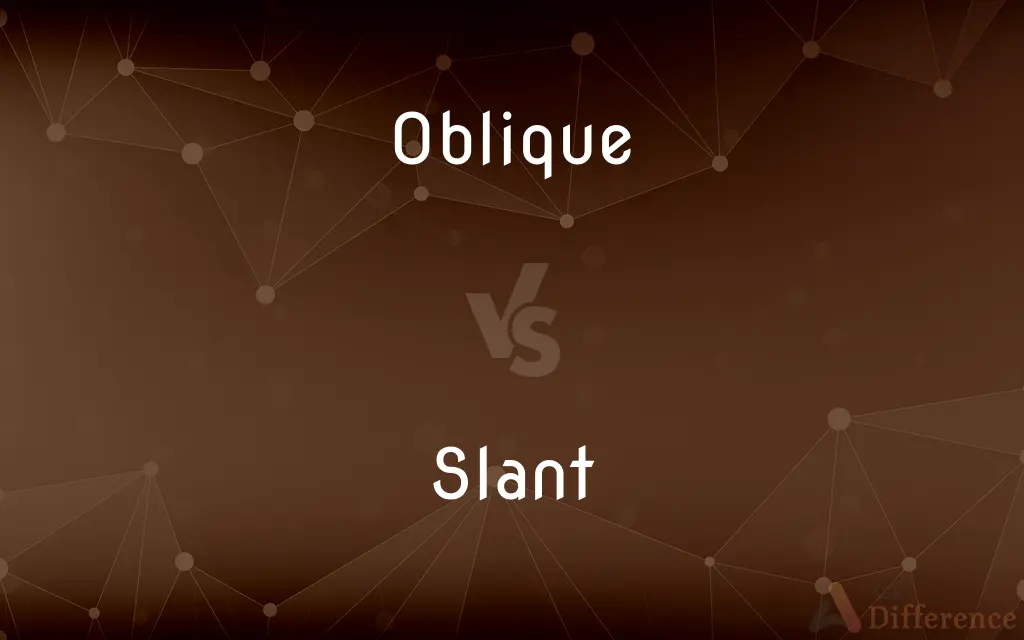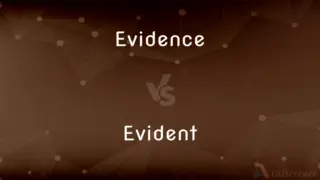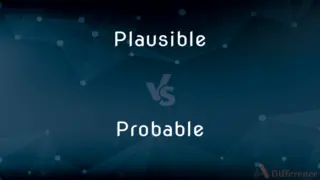Oblique vs. Slant — What's the Difference?
By Fiza Rafique & Maham Liaqat — Updated on March 13, 2024
Oblique refers to a slanted direction or angle, often used in geometry and typography, while slant emphasizes a sloping line or direction, commonly in everyday contexts.

Difference Between Oblique and Slant
Table of Contents
ADVERTISEMENT
Key Differences
Oblique angles in geometry are those that are not perpendicular or right angles, indicating a deviation from a straight or right angle towards a slanted position. In typography, an oblique font style is a slanted version of a font, designed to give emphasis or distinction. Slant, on the other hand, refers to the degree of slope or tilt of a line or surface, often used to describe natural or man-made slopes, handwriting styles, or general attitudes in writing or perspective.
The term oblique is often associated with precision and is used in contexts requiring specific descriptions of angles or orientations, such as in mathematics, art, and design. It suggests a deliberate deviation from the norm or standard, implying a designed or intentional angle. Slant, however, is more versatile, applying to both physical slopes and metaphorical biases or viewpoints, indicating a less formal and more general directionality or inclination.
In physical terms, an oblique muscle or structure in the body, such as the oblique abdominal muscles, refers to muscles that run at an angle to the standard anatomical axes, providing support and enabling rotation. A slant in physical contexts might refer to the slope of a hill, the angle of a roof, or the direction of writing on a page, emphasizing the idea of a lean or tilt from the vertical or horizontal.
In language and journalism, a slant means a particular point of view or bias, especially in the way a story is presented, which can influence the reader's perception. This is distinct from the more neutral or structural implication of oblique, which, outside of typography, rarely conveys bias or perspective.
The choice between oblique and slant often depends on the context and the precision needed in describing an angle, slope, or perspective. While both terms share similarities in denoting angles away from the perpendicular or horizontal, oblique often carries a sense of specificity and design, whereas slant emphasizes directionality and can also imply bias or a less formal inclination.
ADVERTISEMENT
Comparison Chart
Definition
Refers to a specific slanted angle or direction, often with a sense of precision.
Emphasizes a sloping line or direction, with a broader and sometimes metaphorical use.
Usage Context
Geometry, typography, anatomy
Everyday language, journalism, descriptions
Connotation
Precision, designed angle
General slope, bias, perspective
Examples in Physical World
Oblique angles, oblique muscles
Hill slopes, roof angles
Metaphorical Use
Less common, mainly structural in design
Bias, point of view, writing style
Compare with Definitions
Oblique
Muscles at an angle.
Oblique abdominal exercises target the side stomach muscles.
Slant
Directionality in handwriting.
Her handwriting had a distinctive rightward slant.
Oblique
Implies intentionality.
The artist's oblique lines added depth to the painting.
Slant
Broadly used term.
They noticed the slant in the way the news was reported.
Oblique
Angles not at a right angle.
In architecture, oblique angles are used for dynamic visual effects.
Slant
From physical slopes to opinions.
The teacher explained the slant of the historical narrative.
Oblique
A slanted font style.
The report used oblique text for emphasis.
Slant
Refers to tilt or lean.
The slant of the roof allows rainwater to drain off.
Oblique
More structural or descriptive.
The sculpture's oblique stance evoked a sense of movement.
Slant
Implies bias or perspective.
The article had a political slant.
Oblique
Having a slanting or sloping direction, course, or position; inclined.
Slant
To give a direction other than perpendicular or horizontal to; make diagonal; cause to slope
She slants her letters from upper right to lower left.
Oblique
(Mathematics) Designating geometric lines or planes that are neither parallel nor perpendicular.
Slant
To present so as to conform to a particular bias or appeal to a certain audience
The story was slanted in favor of the strikers.
Oblique
(Botany) Having the part on one side of the midrib of a different size or shape than the part on the other side. Used of a leaf.
Slant
To have or go in a direction other than perpendicular or horizontal; slope.
Oblique
(Anatomy) Situated in a slanting position; not transverse or longitudinal
Oblique muscles or ligaments.
Slant
A line, plane, course, or direction that is other than perpendicular or horizontal; a slope.
Oblique
Indirect or evasive
Oblique political maneuvers.
Slant
A sloping thing or piece of ground.
Oblique
Devious, misleading, or dishonest
Gave oblique answers to the questions.
Slant
(Printing) A virgule.
Oblique
Not direct in descent; collateral.
Slant
A personal point of view or opinion
An article with an unconventional slant.
Oblique
(Grammar) Designating any noun case except the nominative or the vocative.
Slant
A bias
An anti-religious slant.
Oblique
An oblique thing, such as a line, direction, or muscle.
Slant
Offensive Slang Used as a disparaging term for a person of East Asian birth or ancestry.
Oblique
At an angle of 45°.
Slant
A slope; an incline, inclination.
The house was built on a bit of a slant and was never quite level.
Oblique
Not erect or perpendicular; not parallel to, or at right angles from, the base.
Slant
A sloped surface or line.
Oblique
Not straightforward; obscure or confusing.
Slant
(mining) A run: a heading driven diagonally between the dip and strike of a coal seam.
Oblique
Disingenuous; underhand; morally corrupt.
Slant
(typography) slash, particularly in its use to set off pronunciations from other text.
Oblique
Not direct in descent; not following the line of father and son; collateral.
Slant
An oblique movement or course.
Oblique
Having the base of the blade asymmetrical, with one side lower than the other.
Slant
(biology) A sloping surface in a culture medium.
Oblique
Growing at an angle that is neither vertical nor horizontal.
Slant
A pan with a sloped bottom used for holding paintbrushes.
Oblique
(grammar) Pertaining to the oblique case (non-nominative).
Slant
A depression on a palette with a sloping bottom for holding and mixing watercolours.
Oblique
Indirect; employing the actual words of the speaker but as related by a third person, having the first person in pronoun and verb converted into the third person and adverbs of present time into the past, etc.
Slant
A palette or similar container with slants or sloping depressions.
Oblique
(music) Employing oblique motion, motion or progression in which one part (voice) stays on the same note while another ascends or descends.
Slant
A sarcastic remark; shade, an indirect mocking insult.
Oblique
(geometry) An oblique line.
Slant
(slang) An opportunity, particularly to go somewhere.
Oblique
Synonym of slash⟨/⟩.
Slant
A crime committed for the purpose of being apprehended and transported to a major settlement.
Oblique
(grammar) The oblique case.
Slant
A point of view, an angle.
It was a well written article, but it had a bit of a leftist slant.
Oblique
(intransitive) To deviate from a perpendicular line; to become askew;
Slant
(US) A look, a glance.
Oblique
(military) To march in a direction oblique to the line of the column or platoon; — formerly accomplished by oblique steps, now by direct steps, the men half-facing either to the right or left.
Slant
A person with slanting eyes, particularly an East Asian.
Oblique
To slant (text, etc.) at an angle.
Slant
(ambitransitive) To lean, tilt or incline.
If you slant the track a little more, the marble will roll down it faster.
Oblique
Not erect or perpendicular; neither parallel to, nor at right angles from, the base; slanting; inclined.
It has a direction oblique to that of the former motion.
Slant
(transitive) To bias or skew.
The group tends to slant its policies in favor of the big businesses it serves.
Oblique
Not straightforward; indirect; obscure;
The love we bear our friends . . . Hath in it certain oblique ends.
This mode of oblique research, when a more direct one is denied, we find to be the only one in our power.
Then would be closed the restless, oblique eye.That looks for evil, like a treacherous spy.
Slant
To lie or exaggerate.
Oblique
Not direct in descent; not following the line of father and son; collateral.
His natural affection in a direct line was strong, in an oblique but weak.
Slant
Sloping; oblique; slanted.
Oblique
An oblique line.
Slant
To be turned or inclined from a right line or level; to lie obliquely; to slope.
On the side of younder slanting hill.
Oblique
To deviate from a perpendicular line; to move in an oblique direction.
Projecting his person towards it in a line which obliqued from the bottom of his spine.
Slant
To turn from a direct line; to give an oblique or sloping direction to; as, to slant a line.
Oblique
To march in a direction oblique to the line of the column or platoon; - formerly accomplished by oblique steps, now by direct steps, the men half-facing either to the right or left.
Slant
A slanting direction or plane; a slope; as, it lies on a slant.
Oblique
Any grammatical case other than the nominative
Slant
An oblique reflection or gibe; a sarcastic remark.
Oblique
A diagonally arranged abdominal muscle on either side of the torso
Slant
Inclined from a direct line, whether horizontal or perpendicular; sloping; oblique.
Oblique
Slanting or inclined in direction or course or position--neither parallel nor perpendicular nor right-angular;
The oblique rays of the winter sun
Acute and obtuse angles are oblique angles
The axis of an oblique cone is not perpendicular to its base
The axes are perpendicular to each other
Slant
A biased way of looking at or presenting something
Oblique
Indirect in departing from the accepted or proper way; misleading;
Used devious means to achieve success
Gave oblique answers to direct questions
Oblique political maneuvers
Slant
Degree of deviation from a horizontal plane;
The roof had a steep pitch
Slant
Lie obliquely;
A scar slanted across his face
Slant
Present with a bias;
He biased his presentation so as to please the share holders
Slant
To incline or bend from a vertical position;
She leaned over the banister
Slant
Heel over;
The tower is tilting
The ceiling is slanting
Common Curiosities
What is an oblique angle?
An oblique angle is any angle that is not a right angle, often found in geometry, indicating a slant away from perpendicular lines.
What does slant mean in writing?
In writing, a slant refers to a particular viewpoint, bias, or way of presenting information, often influencing how content is perceived.
Can the term slant be used to describe physical objects?
Yes, slant can describe the physical slope or tilt of an object, like the angle of a roof or a hill.
Why might a designer choose an oblique angle in their work?
Designers might choose oblique angles to introduce dynamism, tension, or visual interest in their work, as these angles can create a sense of movement and depth.
How is oblique used in typography?
In typography, oblique refers to a typeface that is slanted, similar to italics, used to emphasize text.
How does the concept of a slant apply in journalism?
In journalism, a slant refers to presenting news or stories with a particular bias or perspective, which can subtly influence the audience's understanding and reaction to the information.
How can understanding the difference between oblique and slant benefit students or professionals?
Understanding these differences can enhance clarity in communication, especially in fields like geometry, design, anatomy, and journalism, by enabling more precise descriptions of angles, orientations, biases, and perspectives.
Is oblique always related to angles?
While often associated with angles, oblique can also describe anything that deviates from the straight or horizontal, including muscles in anatomy and elements in design.
What distinguishes an oblique muscle from other muscles?
Oblique muscles are distinct because they run at an angle to the body's standard anatomical axes, enabling rotational movements and contributing to the body's core stability.
Is there a technical difference between italic and oblique typefaces?
Yes, technically, italic typefaces are not just slanted but also have alterations in the shape of the letters, giving them a more handwritten appearance, whereas oblique typefaces are simply slanted versions of the standard font without shape modifications.
Share Your Discovery

Previous Comparison
Evidence vs. Evident
Next Comparison
Plausible vs. ProbableAuthor Spotlight
Written by
Fiza RafiqueFiza Rafique is a skilled content writer at AskDifference.com, where she meticulously refines and enhances written pieces. Drawing from her vast editorial expertise, Fiza ensures clarity, accuracy, and precision in every article. Passionate about language, she continually seeks to elevate the quality of content for readers worldwide.
Co-written by
Maham Liaqat













































